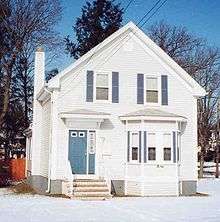Gablefront house


A Gablefront house, also known as a Gable Front house or Front Gable house, is a vernacular (or "folk") house type in which the Gable is facing the street or entrance side of the house.[1] They were built in large numbers throughout the United States primarily between the early 19th century and 1920. A Gablefront cottage is a smaller variant, consisting of either a single story or a story-and-a-half. They were typically used as working-class dwellings, most being rather simple in design. However, they may contain some ornamentation such as brackets around the doorways or roof line. Many gablefront houses contain front porches.[2]
History
The Gablefront house developed after 1825 and coincided with the popularity of the Greek Revival style, which placed emphasis on the gable-end of the house in the form of a pediment; often associated with Greek temples.[3]
The gablefront house allows the narrow part of the house to face the street, usually on a typically rectangular lot. The gablefront house became a uniquely American folk house type. The Gablefront house cropped up in styles ranging from Greek Revival, to Gothic Revival, to Queen Anne, to a simpler vernacular style home.[4] The Gablefront house form remained popular into the early 20th century.[5]
Variants
Gabled Ell
One variation of the Gablefront house is the Gabled Ell. The Gabled Ell incorporated a side gable, which was typically added-on to the house. The add-on was usually in order to obtain additional space, light and cross-ventilation.
T-plan
Another variation of this house form is the T-plan house. The T-plan house consists of gable-ends on either side of the front-facing main gable.